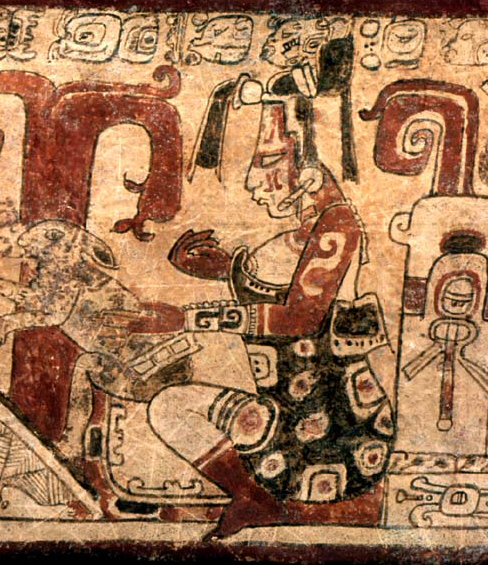“I curse you, little seizures! Whose erupting pox are you? Eruptions on the head and body, open eruptions, internal eruptions, fiery eruptions…” [1] So begins a highly ritualized remedy for fever, eruptions, and seizures from late colonial Yucatán. As I noted in my last post, sickness and disease were endemic throughout colonial Latin America and brought together distinct traditions of healing. As this remedy and the dozens of others from the manuscript known as Ritual of the Bacabs show, eighteenth-century Mayas of the Yucatán were not silent victims of disease. Instead, they understood sickness and infirmity as extensions of the natural and human world. They incorporated ancient traditions and firmly rooted healing in colonial context. And, as I would like to note in this post, healers personified and naturalized diseases to bolster their own therapeutic powers.
Before returning to this remedy, I want to touch on the manuscript source and then briefly make note of ancient traditions of Maya healing. Ritual of the Bacabs is a collection of healing incantations, prayers, and remedies written in Yucatec Maya sometime in the eighteenth century. This unique work, which today is held at Princeton University, addresses afflictions common to the colonial world, including pox (kak), difficulty breathing (coc), and difficulty walking (chibal oc). The devastating affects of disease are often noted as seizures (tancas). Several cures associate these outbursts with their origins, such as walking seizures (ah oc tancas), while others ascribe direct ties to the natural world as their sources, including macaw-jaguar seizures (mo balam tancas) and tarantula seizures (chiuoh tancas). The culturally bound ailment often described as madness (coil) regularly appears associated with extreme cases of the pox and seizures.
On the whole, the remedies of the text illustrate the ongoing revision of long-standing Maya traditions in the face of colonial institutions. In particular, in the pre-Hispanic period, infirmity and remediation were associated with the supernatural world and directly tied to the deities Ix Chel and Itzamná. In 1571, Diego de Landa, the second Bishop of Yucatán and infamous crusader against pagan practices, noted Ix Chel’s centrality to healing.
“The physicians and the sorcerers assembled in one of their houses with their wives… they opened bundles of their medicine, in which they kept many little things… little idols of the goddess of medicine, whom they called Ix Chel .”
Diego de Landa, ca. 1570
The two deities, the goddess of the moon and lord of the sun, were bound as husband and wife and mirroring elements of health and sickness.

This rollout image from a classic period pot depicts the goddess Ix Chel (center) caring for an ailing Itzamná (right) and a female healer (left) performing a healing ritual. The leaves surround the infirmed and bedridden Itzamná most likely represent the purgatives used to induce the deer to vomit. A vulture appears underneath the old god’s bed, just to make clear that his condition is dire. © Justin Kerr, K2794, www.mayavase.com
During the colonial period, local Church authorities attempted to root out any expressed association with ancient religions. In healing, however, it is clear they were unsuccessful. These deities, who were central to the creation mythology of the Classical Maya, were represented as powerful animistic forces in the healing text. In a remedy for a breathing affliction in Ritual of the Bacabs, both Itzamna and Ix Chel are invoked to harness the use of the powerful cardinal directions. The enchanter is to “for four days, shake the face of the red Ix Chel, the white Ix Chel, the yellow Ix Chel; four days he shakes the face of the red Itzamna.” [3] These supernatural forces figure prominently in the background of numerous remedies. They serve to root the cures in line with ancient traditions, which endured well into the colonial period.

In this image from a Classic period earthenware polychome vase, a seated Ix Chel appears with her rabbit, which is often identified as one of her animal spirit companions. She appears as a young woman, dressed in the regalia of a noble, complete with headdress. The original object is housed at Museum of Fine Arts Boston and available digitally here.
The remedies of Ritual of the Bacabs represent a clandestine system of ritualized healing that directly built on past Maya practices, such as the invocation of Ix Chel. As a text designed for alienating and eliminating sickness, the curanderos that penned the work most likely identified themselves as a special Maya class of healers known as mak ik or benevolent shamans that controlled healing winds. In this way, they stood in line with ancient traditions, but were fully immersed in colonial experience.
[1] Ritual of the Bacabs, Princeton University Library, Garrett-Gates Collection, Mesoamerican Manuscript No. 1, folio 100.
[2] Diego de Landa and Alfred M. Tozzer, Landa’s Relación De Las Cosas De Yucatan: A Translation. (New York: Kraus, 1966), 154.
[3] Ritual of the Bacabs, folio 65.
Cite this blog post
RA Kashanipour (2022, March 24). Sickness Personified: Clandestine Remedies from Colonial Yucatán. The Recipes Project. Retrieved April 18, 2024, from https://doi.org/10.58079/tdcd